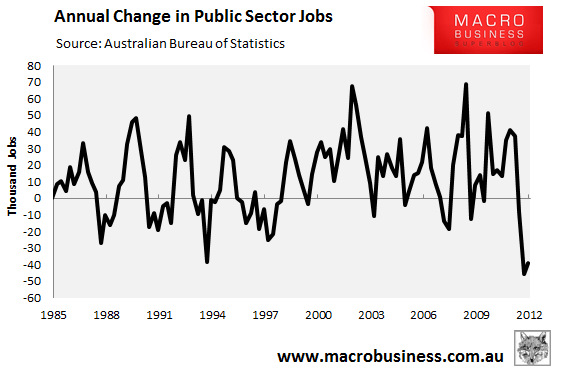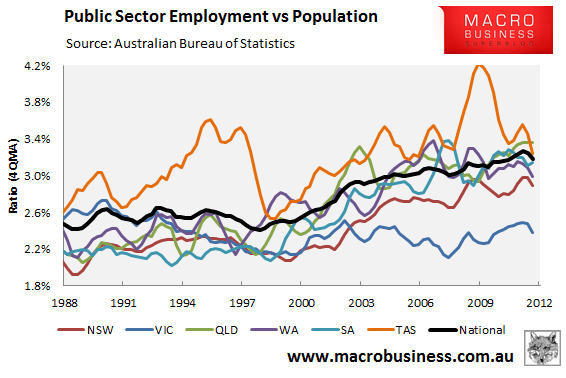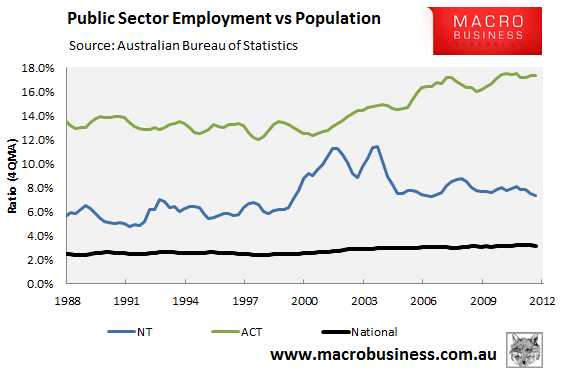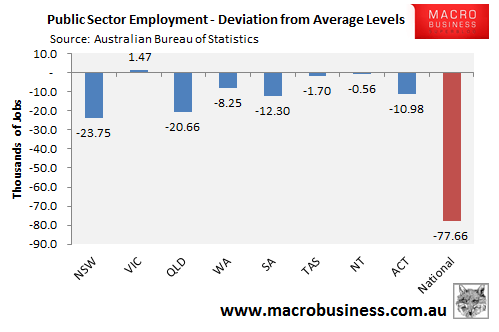
Fairfax’s Peter Martin has an interesting take this morning on yesterday’s disappointing ABS job vacancies release, whereby the total number of job vacancies fell to the lowest level in 30-months. From the Age:
AUSTRALIA’S supply of vacant jobs is dwindling, making it harder to find work than it has been in years. New results from the only comprehensive national survey of vacancies show they have slid 8 per cent in the past year, undoing most of the gains since the global financial crisis.
Australia had only 166,000 vacant jobs in November, down from 193,000 two years earlier. More than 600,000 Australians were looking for work.
The most dramatic slide has been in public sector vacancies. There were just 12,300 government or semi-government jobs on offer during November, down from 17,500 a year earlier. In the public service capital of Canberra, the Bureau of Statistics found just 800 vacant jobs, the least since the early years of the Howard government in 1998.
Recently elected state governments have also cut public service employment to long-term lows. There were just 3100 public vacancies in NSW – the fewest at that time of year since 1996. There were just 2900 in Victoria, the weakest since 2003 and just 2100 in Queensland, the weakest since 1999.
Queensland has 29 per cent fewer vacancies than it had a year ago and 65 per cent fewer public service vacancies…
The ABS job vacancy survey is regarded as more reliable than the private sector advertisement surveys because it seeks details of all vacancies, whether or not they are advertised.
It shows Tasmanians are in the worse state in which to search for a job. It has eight unemployed people competing for each vacant job. The West Australian and Northern Territory labour markets remain Australia’s healthiest with only 1.5 and 1.3 people competing for each vacant job.
In Victoria there are 3.9 people competing for each vacant job, in NSW the figure is 4, and in Queensland it is 4.3.
The point about the slide in public sector job vacancies is interesting. As noted previously, the ongoing slump in stamp duty and GST receipts – both of which are a major source of tax revenue for the states and territories – as well as sliding company tax and capital gains tax receipts at the federal level, have forced Australia’s governments to make cut backs to government expenditure and public sector jobs. In fact, the latest quarterly ABS employment report showed that “public administration and safety” – a proxy for the public sector bureaucracy – shed nearly -40,000 jobs in the year to November 2012, which was the biggest retrenchement of any industry in Australia (see below chart).

While the level of public sector retrenchment has been significant over the past year, it would appear that further job cuts might be required in order to restore public sector employment to historical norms. To illustrate, the next charts plot the proportion of the population working in “public administration and safety” against the population in each state and territory in order to see how public sector employment has changed over time:


As you can see, the bureaucracy has grown significantly since the late-1990s, from around 2.5% of Australia’s population in 1998 to around 3% currently.
The increase in the public sector workforce could be explained by the surge in taxation revenue following the property boom, which significantly increased stamp duty receipts, as well as the introduction of the GST in 2000, which is redistributed from the Commonwealth to the states and territories. Increasing mining royalties have also played a role in Western Australia, Queensland, and New South Wales, whereas the joint mining and property booms increased personal, capital gains and company taxes federally. The large boost in tax revenues allowed Australia’s governments to grow the public service whilst still maintaining healthy finances.
However, with stamp duties and GST revenue no longer growing as expected, as well as lower company tax and capital gains receipts (amongst other things), the state, territory, and federal governments are now being forced to cut back on expenditure and jobs in an attempt to restore their budgets to surplus and protect their credit ratings.
A back-of-the-envelope calculation suggests that the public service head count would need to be cut by nearly -80,000 nationally in order to shrink the public service back to its average level since 1984 (2.7% of the population), although the cuts would not be uniform across jurisdictions:


